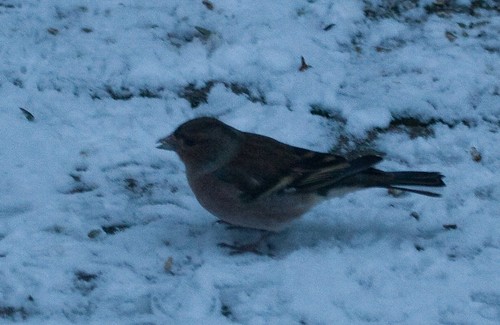All the winter journals are coming out and Harry gets several mentions.
In American Birds (the Christmas Bird Count Summary), Wayne Petersen, in the New England summary, writes:
Top billing for the 110th New England CBC belongs to the Common Chaffinch on the Greater Boston count. Although the bird’s provenance may never be known with certainty, this species’ periodic occurrence in northeastern North America has led to its inclusion on the A.O.U. Checklist of North American Birds (1998). Present at a feeder throughout December, the chaffinch was observed and photographed by dozens of birders and eventually banded, hence its identity was unequivocal.
An excellent photo taken on count day (at about 7AM so barely light out).
It looks like the magazine will be online at some point, link to be added here when I see it.
And in North American Birds, the Changing Seasons column by Ned Brinkley (2.4MB PDF) says (p. 221):
The backyard produces endless questions to which we have no answer. Shall we take a vote on how a Common Chaffinch got to Waltham, Massachusetts this season (Figure 12)? I suspect we would find a range of views. Two and a half months into its stay, the bird was captured so that feather samples could be taken, in hopes that the stable isotopes therein would provide clues to where the bird came from. With extensive releases of Eurasian finches (as well as Great Tits, Blue Tits, and Eurasian Jays) in the Chicago area in recent years, we may have a more colorful avifauna now, but we have a formidable challenge if we want to make sense of records of Common Chaffinch, European Goldfinch, and Eurasian Siskin, all of which stray to Iceland and are thus potential visitors to the Northeast, at least. To many birders, released birds might seem a negligible factor, because we ourselves see so few. One industrious birder-ornithologist, curious about a rash of reports, set out to locate as many records of European Goldfinch as possible (Craves 2008); she turned up over 400 records of the species, spanning almost half the continent, including multiple breeding records from the Midwest. So far, these escapee-expatriates have not begun to barnstorm their new continent in the way that Eurasian Collared-Doves have. But what do their patterns of dispersal look like? Might they end up in Massachusetts or eastern Canada, places that have most of the continent’s records of vagrant European passer- ines considered legitimate? Other Old World backyard birds, such as a Violet Turaco that frequented a feeder at Lac-Beauport, Québec through December—“a shocking sight in the snow,” according to regional editors—are less likely to provoke debates about provenance.
Figure 12 is one of Jeremiah’s excellent shots.
And in the New England summary, Pam Hunt writes:
On par with the Bay State’s shelduck was a Common Chaffinch that appeared at a Waltham feeder 1 Dec and stayed through Mar (J. Forbes, m.ob., ph.). The bird was captured 15 Feb and feather samples taken for isotopic analysis, the intent being to determine where it was hatched. Given the cluster of escaped European fringillids in the Midwest in recent years, this individual could certainly be an escapee; perhaps the isotopic truth is out there.
One of my banding photos is on page 232 (A Common Chaffinch that appeared 1 December 2009 at a feeder in Waltham, Massachusetts was captured 15 February 2010 for banding. In an attempt to determine the bird’s provenance, feather and blood [??] samples will also be analyzed.)
